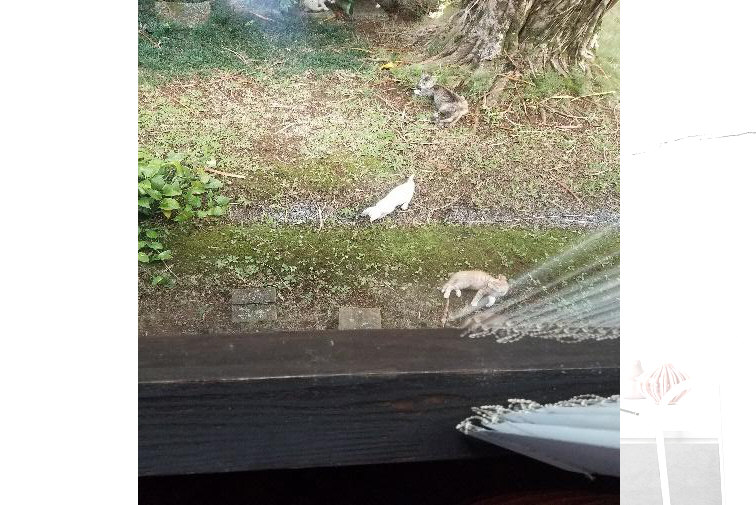A Free-Roaming Cat Family and Me (Part 3)

as seen from a living room window years after we first met.
Part 3
Before the cats appeared, I’d hung a bird feeder in a Madagascar Dragon Tree. This changed the ecology of the down-sloping backyard overflowing with strawberry guava, tangerine and banana trees, ferns, and anthurium plants (which my mom used to call “little boy flowers”). Dozens of rice birds, cardinals, and a few wild green parrots fought for rice and black sunflower seeds, entertaining Lily, who sat on her long couch looking through a large picture window, silently watching the backyard she’d planted over 60 years ago.
I prefer the term “community” to “feral,” which means “wild” or “savage,” because humanely cared for outdoor cats become more like domesticated cats than wild cats fighting to survive. Once cats are neutered, they become quieter as mating behaviors like yowling and fighting stop, and healthier, because deadly diseases can be spread during mating.
My friend Emily, who helps feed a colony of 200 community kitties, tells me it’s too late for socialization when kittens are 8 weeks old. “The time limit’s about a month,” Emily said. The most humane solution for outdoor cats is to trap, neuter, and return them to the area from whence they came. During the past 20 years, Emily has trapped more than 1,500 cats and had them neutered. Kudos to Emily and all the others who feed, water, and rescue cats living outdoors and get them fixed so they stop birthing babies every 3 or 4 months. A treasure-house of knowledge, she advised me not to get the cat family neutered until the kittens were 8 weeks old.
Once that day arrived, Emily loaned me her humane trap and showed me how to set it. I tested it; put tuna inside, watched Mama Kitty walk inside and eat the food. I almost didn’t catch the green-eyed beauty because I had to manually drop the back door rather than risk the trap door crashing down on her. She twirled fast as the wind inside the cage until I covered it with two towels and she couldn’t see out. I captured her two white kitties, Big White and Little White, in a cat kennel by hooking the door while they were busy eating. But Little Yellow got away.
So it was back to Emily to borrow another trap. The trap caught Little Yellow, who managed to stick her paw through one end of the wire cage and bat at some leaves. How could anyone deliberately kill a playful kitten like her? I will never understand.
The next day, Mama Kitty and her three daughters headed to Cat Friends to be fixed. I hoped Mama would fatten up. She was skinny as a stick from nursing the kittens for so long. Weeks later, she was still skinny, perhaps because this dedicated mama wouldn’t eat much until after her three kittens were fed. That’s changed now. Mama Cat is so rolly polly I sometimes call her Wide Load, a moniker I picked up from my humorous dad for the crippled quail he and Mom overfed in their Tucson home. .
Read More:
Part 1
Part 2
Part 3
Part 4
Part 5

Lizbeth Hartz is the author of the true crime, true love memoir Angel Hero, Murder in Hawaii, A True Story. Buy it on Amazon or sign up to read the 1st chapter free.